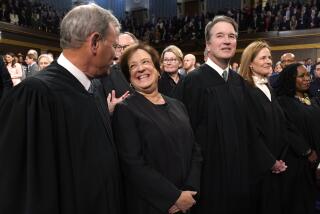‘Original intent’ matter of opinions
WASHINGTON — In 1985, President Reagan’s attorney general, Edwin Meese III, criticized the Supreme Court’s decisions and called on the justices to decide cases based on the “original intent” of the Constitution. The justices were wrong to rely on contemporary views of liberty and equality, Meese said; instead, they should rely on the understanding of those concepts in the late 18th century, when the Constitution and the Bill of Rights were written.
This year the Supreme Court relied more than ever on history and the original meaning of the Constitution in deciding its major cases.
In doing so, however, the court has drawn criticism from some historians and legal experts who say the justices’ readings of history were less than scholarly. And the justices sometimes disagreed sharply on the historical record, demonstrating that divining the original meaning of the Constitution is no small matter.
The term’s two most important opinions -- on the reach of habeas corpus in the war on terrorism, and on the meaning of the 2nd Amendment -- trace the origins of the right to go to court and the right to “keep and bear arms” to 17th century England and Colonial America.
All nine justices agreed that the original understanding was crucial. However, they split 5 to 4 in both cases on how to interpret the history.
In the case of Guantanamo Bay detainees, Justice Anthony M. Kennedy cited early English cases in which Spanish sailors and African slaves petitioned a judge for their freedom. This suggests that the right of habeas corpus was not limited to English subjects, he said. Rather, when this right was written into the U.S. Constitution in 1787, it set a basic principle of liberty that protects people who are captured and held by the government, including the foreign prisoners held at Guantanamo, Kennedy said in Boumediene vs. Bush.
Wrong, Justice Antonin Scalia wrote in dissent. He said English history showed that the writ of habeas corpus was limited to sovereign English territory. It certainly did not extend to prisoners captured abroad by soldiers or sailors, he said.
In the other case, District of Columbia vs. Heller, the justices wrote about 150 pages of opinion and dissent on whether the 2nd Amendment was intended to preserve a “well-regulated militia” in each state or to protect an individual’s right to keep a gun for self-defense.
Scalia, speaking for a 5-4 majority, described how the Stuart kings of England had held power by confiscating the arms of their opponents. This, in turn, led to their overthrow and to the English Bill of Rights of 1689, which said Englishmen “may have arms for their defense.”
Scalia also cited studies by UCLA law professor Eugene Volokh and others showing that some Colonial-era state constitutions spoke of a right “to bear arms for the defense of themselves and the state.” This suggests that the right to bear arms extended beyond service in the state militia.
In dissent, Justice John Paul Stevens said Scalia was looking in the wrong place. James Madison, the author of the Bill of Rights, rejected broader proposals and focused on preserving “a well-regulated militia” and a right to “bear arms” in military service, Stevens contended.
The phrase “bear arms” referred to military service, he added. In a footnote, he quoted a judge in the 19th century saying, “A man in the pursuit of deer, elk and buffaloes might carry his rifle every day for 40 years, and yet it would never be said of him that he had borne arms.”
The court’s new focus on history drew the attention -- and some snide blog postings -- of legal historians who faulted the justices for selectively citing cases and writings to bolster their favored view.
“Neither of the two main opinions in Heller would pass muster as serious historical writing,” Stanford University historian Jack Rakove wrote on a blog called Balkinization.
Neither Scalia nor Stevens is a “competent historian,” University of Texas at Austin professor Sanford Levinson wrote in another Balkinization posting. Their work is “what is sometimes called ‘law-office history,’ in which each side engages in shamelessly (and shamefully) selective readings of the historical record in order to support what one suspects are predetermined positions.”
Harvard law professor Mark Tushnet, like Levinson, has studied the 2nd Amendment. Tushnet wrote that both opinions “demonstrate why judges shouldn’t play historian.”
History is complicated, Tushnet suggested, but the law requires clear answers, and the justices “share the natural human tendency to exaggerate the case that can be made for the side they ultimately favor.”
The court’s focus on history went well beyond those two cases. The justices cited a series of early shipwreck cases to help decide whether Exxon could be forced to pay punitive damages for the 1989 Exxon Valdez oil spill off Alaska.
“The modern Anglo-American doctrine of punitive damages dates back at least to 1763,” Justice David H. Souter wrote in Exxon Shipping Co. vs. Baker. He noted that an ancient forerunner of the notion of punitive damages is found in a case under the Code of Hammurabi from Babylon, which established the principle that the penalty for stealing a goat was 10 times its value.
Even a Los Angeles murder case was decided largely on English history.
Dwayne Giles shot and killed his girlfriend Brenda Avie in 2002. He claimed self-defense, but a police officer testified to the jury that three weeks before the shooting, Avie said Giles had threatened to kill her.
In Giles vs. California, Scalia said the police officer’s testimony violated the defendant’s right to “confront” the witnesses against him. Avie was dead and could not testify, so the judge should not have allowed her words to be read to the jury, Scalia said, unless prosecutors could show that Giles killed her in order to silence her testimony.
According to Scalia, this “doctrine has roots in the 1666 decision in Lord Morley’s case,” which set the rule that statements of a missing witness may not be used unless the witness was “kept away” by the “means or procurement” of the defendant. Scalia drew the lesson that statements to the police may not be used at a trial unless the defendant intentionally “procured” the absence of the witness.
In dissent, Justice Stephen G. Breyer said it was bizarre to rely on snippets of 17th century English cases to decide the Constitution today. “Each year, domestic violence results in more than 1,500 deaths” in this country, he said, and there is no good reason for giving a defendant “a windfall” for killing the witness against him.
Scalia was appointed to the court by Reagan in 1986, a year after Meese’s speech, and he advocated a historical approach. Justice Clarence Thomas, who joined the court in 1991, followed suit. Since the arrival of Chief Justice John G. Roberts Jr. and Justice Samuel A. Alito Jr. in the last couple of years, Scalia has more often found himself in the position of speaking for the court’s majority rather than firing off opinions in dissent.
--
More to Read
Sign up for Essential California
The most important California stories and recommendations in your inbox every morning.
You may occasionally receive promotional content from the Los Angeles Times.











